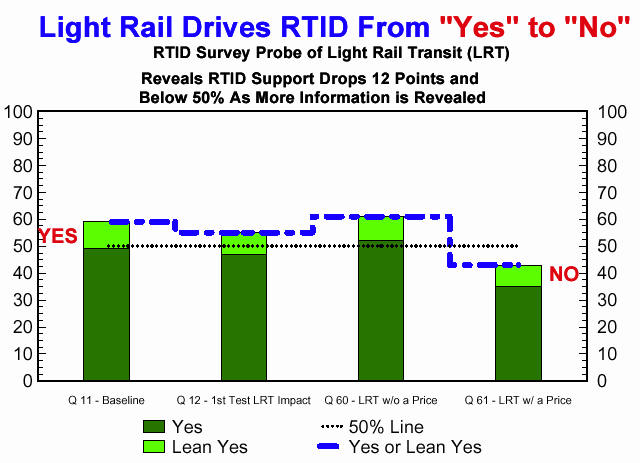Public Interest Transportation Forum http://www.bettertransport.info/pitf
![]()
![]()
Some politicians and journalists have made statements to the effect that the November 2003 survey conducted by professional opinion survey firms on behalf of the Puget Sound Regional Transportation Investment District (the RTID with a website at http://www.rtid.dst.wa.us/) shows that light rail is very popular. Some people are saying that adding funding for light rail to a Puget Sound regional funding proposal for improved roads and transit would improve the odds of the proposal passing with voters.
Not so! This false conclusion is based on selective reporting in support of a spin from light rail boosters who know the Sound Transit Central Link Light Rail project desperately needs RTID funding to survive.
As an example of selective reporting, the December 11, 2003 Tacoma News Tribune reported this highlight: "61 percent said they would vote for the plan if it included money to extend light rail to reach Northgate and Sea-Tac Airport, while 32 percent said they would vote against it." This was based on just one question, number 60, which specifically asked, "What if the Regional Transportation Investment Plan included extending light rail to the north to reach the Northgate transit center and south to reach SeaTac airport, and would be funded specifically by taxes raised in King County? Knowing this, if the election were held today would you vote yes to enact or no to reject the Regional Transportation Investment Plan?"
What is not reported in the Trib story is that when the next question in the poll, number 61, was asked, indicating the cost of a plan that included light rail, the "yes" vote plunged to 43% and the "no" vote jumped to 53%. In other words, Link Light Rail with the price stated sinks RTID. Question 61 is shown in the far right hand bar in the graph below, showing that the "yes" opinion on this question dropped below 50%.
An analysis of the results of the November 2003 poll carried out by the Coalition for Effective Transportation Alternatives (CETA, website at http://www.effectivetransportation.org) indicates that indeed light rail as described in the survey is popular in some parts of the region when described in a certain way. However, the clear overall implication of the survey is that adding light rail to the regional package as of last November would lower the probability of voter approval.
Here is a graphical highlight from that report:

(The text of the questions covered by the graphic, numbers 11, 12, 60, and 61, are quoted below.)
CETA's complete analysis focuses on a number of questions and comes out with these conclusions:
| Light rail is more popular in Seattle, less popular outside Seattle. | |
| The attitude of survey respondents did not become more positive to light
rail as they learned more during the survey, except when
learning they might not have to pay for light rail. | |
| Light rail is polarizing, having high negatives and positives. | |
| Light rail popularity in Seattle with 21% of regional voters does not
overcome light rail unpopularity in rest of region with 79% of voters. | |
| Light rail to SeaTac Airport is more popular in the RTID package than
light rail to Northgate, even though Airport Link (low ridership)
is already funded and Northgate Link (higher ridership) is unfunded. | |
| Expanded buses (a transit alternative to light rail) tested better in the survey for the RTID package than light rail does. |
The CETA analysis is available full text in pdf here. It includes the text of each question and the raw "top line" results. This analysis has been submitted to the RTID Executive Committee and to the Washington State House of Representatives Transportation Committee. The CETA report draws upon the results from the poll as provided by the polling firm, available for downloading in the file http://www.rtid.dst.wa.us/Dec 11 2003/RTID Poll.PDF.
Keeping light rail out of the RTID package is completely consistent with having a balanced package of roads and transit. There are many opportunities for including transit investments in the RTID package other than the controversial Link Light Rail. The CETA consensus alternative for a regional transit program without light rail is described at www.effectivetransportation.com.
![]()
![]()